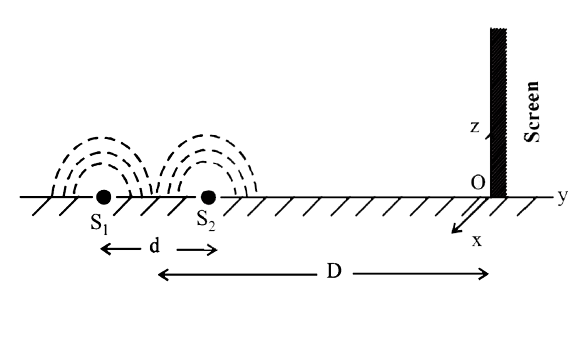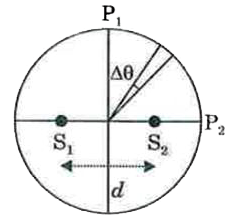OBJECTIVE TYPE QUESTIONS (C. MULTIPLE CHOICE QUESTIONS) from MODERN PUBLISHERS PHYSICS Chapter 106 WAVE OPTICAL for Class 12
| Class 12 | PHYSICS |
| Chapter | WAVE OPTICAL |
| MODERN PUBLISHERS PHYSICS | OBJECTIVE TYPE QUESTIONS (C. MULTIPLE CHOICE QUESTIONS) |
| Medium | English |
| Academic Year | 2023-2024 |
Question 6
In Young' s double-slit experiment, separation between the two slits is d and separation between plane of the slits and the screen is D. A small hole is made on the screen at a point directly in front of one of the slit. Some wavelengths are missing from the light coming out from hole on the other side. These wavelengths are View SolutionQuestion 10
Unpolarised light of intensity I0 is passed through a polaroid A, and intensity of light after passing polaroid A becomes I1. Light emerging from polaroid A is passed through another polaroid B, whose axis is inclined at an angle 60∘ with the axis of A. Intensity of light after emerging from B becomes I2. View SolutionQuestion 11
A light source, which emits two wavelength λ1=400nm and λ2=600nm, is used in a Young's double slit experiment. If recorded fringe width for λ1 and λ2 are β1 and β2 and the number of fringes for them within a distance y on one side of the central maximum are m1 and m2 respectively, thenView SolutionQuestion 13
While conduction the Young's double slit experiment, a student replaced the two slits with a large opaque plate in the x-y plane containing two small holes that act as two coherent point sources (S1,S2) emitting light of wavelength 600nm. The student mistakenly placed the screen parallel to the x-z plane (forz>0) at a distance D=3 m from the mid-point of S1,S2, as shown schematically in the figure. The distance between the sources d=0.6003mm. The origin O is at the intersection of the screen and the line joining S1S2. Which of the following is (are) true of the intensity pattern of the screen?
 View Solution
View SolutionQuestion 14
Two coherent monochromatic point sources S1andS2 of wavelength λ=600nm are placed symmetrically on either side of the centre of the circle as shown. The sources are separated by a distance d=1.8mm. This arrangement produces interference fringes visible as alternate bright and dark spots on the circumference of the circle. The angular separation between two consecutive bright spots is Δθ. Which of the following options is/are correct ?
 View Solution
View Solution
All Exercises from MODERN PUBLISHERS PHYSICS Class 12 PHYSICS WAVE OPTICAL
- CHAPTER PRACTICE TEST
- Conceptual Questions
- Higher Order Thinking Skills & Advanced Level (QUESTIONS WITH ANSWERS)
- NCERT (EXemplar Problems Obejective Questions) (Multiple Choice Questions (Type-I)
- NCERT (EXemplar Problems Obejective Questions) (Multiple Choice Questions (Type-II)
- NCERT (Exemplar Problems Subjective Questions) (Short Answer Type Questions)
- NCERT (Exemplar Problems Subjective Questions) (Very Short Answer Type Questions)
- NCERT FILE SOLVED (Additional Exercises)
- NCERT FILE SOLVED (TEXT BOOK EXERCISES)
- OBJECTIVE TYPE QUESTIONS (A. MULTIPLE CHOICE QUESTIONS)
- OBJECTIVE TYPE QUESTIONS (ASSERTION REASON TYPE QUESTIONS)
- OBJECTIVE TYPE QUESTIONS (B. MULTIPLE CHOICE QUESTIONS) -AIPMT/NEET & OTHER STATE BOARDS FOR MEDICAL ENTRANCE
- OBJECTIVE TYPE QUESTIONS (C. MULTIPLE CHOICE QUESTIONS)
- OBJECTIVE TYPE QUESTIONS (D. MULTIPLE CHOICE QUESTIONS)
- OBJECTIVE TYPE QUESTIONS (INTEGER TYPE QUESTIONS)
- OBJECTIVE TYPE QUESTIONS (JEE (ADVANCED) FOR IIT ENTRANCE)
- OBJECTIVE TYPE QUESTIONS (JEE (MAIN) & OTHER STATE BOARDS FOR ENGINEERING ENTRANCE)
- OBJECTIVE TYPE QUESTIONS (MATCHING TYPE QUESTIONS)
- OBJECTIVE TYPE QUESTIONS (MATRIX MATCH TYPE QUESTIONS)
- PRACTICE PROBLEMS (1)
- PRACTICE PROBLEMS (2)
- PRACTICE PROBLEMS (3)
- PRACTICE PROBLEMS (4)
- Revision Exercises (Additional Questions)
- Revision Exercises (Fill in the Blanks)
- Revision Exercises (Long Answer Questions)
- Revision Exercises (Numerical Problems)
- Revision Exercises (Short Answer Questions)
- Revision Exercises (Very Short Answer Questions)
- SOLVED EXAMPLES
- Tough & Tricky (PROBLEMS)
